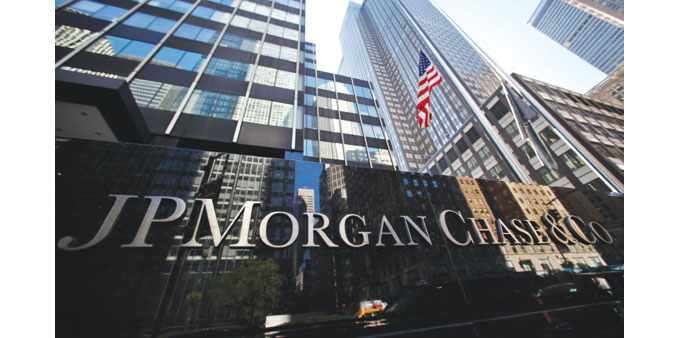The headquarters of JP Morgan Chase & Co in New York. With the Fed on its way to raising rates for the first time in almost a decade, firms like JPMorgan Chase & Co and Goldman Sachs say the bond market is making a mistake in doubting the central bank’s resolve in 2016.
Bloomberg
New York
For years, one of the easiest ways for bond traders to make money has come from being sceptical of the Federal Reserve’s view on interest rates.
Now, some of Wall Street’s most influential firms say those days are about to end.
With the Fed on its way to raising rates for the first time in almost a decade, firms from JPMorgan Chase & Co to Goldman Sachs Group say the bond market is making a mistake in doubting the central bank’s resolve in 2016, especially as the US economy continues to strengthen.
While traders are betting on three quarter-point increases in the next 12 months - fewer than the central bank’s own forecasts imply - they have a history of underestimating the degree of tightening when the Fed finally does start to move, an analysis by Renaissance Macro Research showed.
And bond investors haven’t given themselves much room for error. For the first time prior to a tightening cycle, buyers of two-year Treasuries aren’t demanding any extra compensation for the risk that rates or inflation may rise more than they now expect, according to data compiled by Bloomberg.
“The return on not doing anything, and fading what the Fed is telling you, has been pretty good up until now,” Alex Roever, the head of US interest-rate strategy at JPMorgan, the top- ranked firm for fixed-income research by Institutional Investor magazine, said during a panel discussion on December 2. “We are coming to an inflection point on that.”
Since the financial crisis ended, the bond market has consistently been right in dismissing predictions - from both the Fed and Wall Street - over how soon, and how much, borrowing costs will rise from rock-bottom levels.
In the past five years, yields on 10-year Treasuries, the benchmark rate for just about everyone looking to borrow, have fallen from about 4% to 2.29% in Tokyo.
But JPMorgan says that very same “return on doubt” has lulled bond traders into believing there’s no way they can be wrong this time.
The stakes could hardly be higher. With the size of the global bond market ballooning to about $100tn, any missteps could be magnified and ripple across financial markets.
While Fed officials have repeatedly said the central bank plans to move gradually, all those statements come with one big caveat: it depends on just how much the economy improves. Faster growth and inflation could prompt the Fed to raise rates more quickly than traders are pricing in and prompt a sudden selloff in bonds.
The $13.1tn market for US Treasuries got a taste of what could happen last week, when yields on 10-year notes surged by the most since May after the European Central Bank announced stimulus measures that disappointed investors and Fed Chair Janet Yellen said she expects wage growth to pick up as the US economy strengthens.
In the derivatives market, traders say it will take about two years for the Fed to increase rates to 1.3% from near zero now. That’s far less than the latest median forecast from Fed officials, which suggests they’ll raise it above that level by the end of 2016.
For its part, JPMorgan sees the Fed following up its first hike this month with four more quarter-point increases next year.
It wouldn’t be the first time that traders have erred once the Fed actually starts tightening, according to Renaissance Macro, a New York-based firm that specializes in macro-economic research.
During the early stages of the Fed’s last round of increases in late 2004, traders predicted the target rate would reach 3.6% in a year and 3.9% the following year. They were wrong on both counts. Fed officials ratcheted up borrowing costs to 4.25% at the end of 2005 before peaking at 5.25% in June 2006.
“The bond market is always offsides in the initial phases of the tightening cycle,” said Neil Dutta, the head of US economics at Renaissance Macro.
This time, it’s because traders may still be too complacent about inflation.
While the bond market’s outlook for inflation has diverged from commodities in recent months and rebounded from its low in September, the slump in oil prices and a slowdown abroad are still weighing down expectations, according to Goldman.
Based on Treasury yields, traders see consumer prices rising 1.64% a year over the next decade.
Goldman analysts led by Francesco Garzarelli say that’s too low. They estimate it should be closer to 2% and recommend buying long-term inflation-linked Treasuries rather than their nominal counterparts, which will lose value as consumer prices accelerate.
Inflation “doesn’t seem to be on anyone’s radar at this point,” said Richard Schlanger, a money manager at Pioneer Investments, which oversees $244bn. As such, “the market may not be reflecting the amount of tightening that could take place.”
He bought 10- and 30-year Treasury Inflation-Protected Securities, or TIPS, and is avoiding government debt that matures between two and five years.
Another sign of the market’s complacency is the fact that investors in short-term Treasuries are discounting the possibility things may turn out differently than they expect. That’s reflected in the “term premium,” or the extra yield priced into bonds to account for the risk of surprise moves in interest rates, inflation or supply. For two-year notes, it’s been negative since early 2014 and was at minus 0.29 percentage point last week. In the past three decades, that’s never happened in the lead-up to a tightening cycle, data compiled by Bloomberg show. A big reason traders are so sanguine is that the Fed’s economic forecasts have been off-the-mark, says Western Asset Management Co’s Julien Scholnick.
Three years ago, the median range of estimates from Fed officials showed growth reaching as high as 3.3% in 2016. That’s gradually fallen over time, to just 2.6% in September.
“The Fed has consistently been too optimistic, and they’ve had to consistently lower their growth forecasts,” said Scholnick, a money manager at Pasadena, California-based Western Asset, which oversees $446bn.
Yet even Scholnick is telling the firm’s fund managers to hedge their bets and cut back on short-term Treasuries to avoid any volatility if the Fed does raise rates this month.
That volatility could be coming soon, if strategists at RBC Capital Markets are right. They predict the Fed will raise its rate five times before the end of next year and expect it to peak at 3.5% in 2017. “People will get spooked that the Fed might go much further,” said Michael Cloherty, RBC’s head of US interest- rate strategy.



